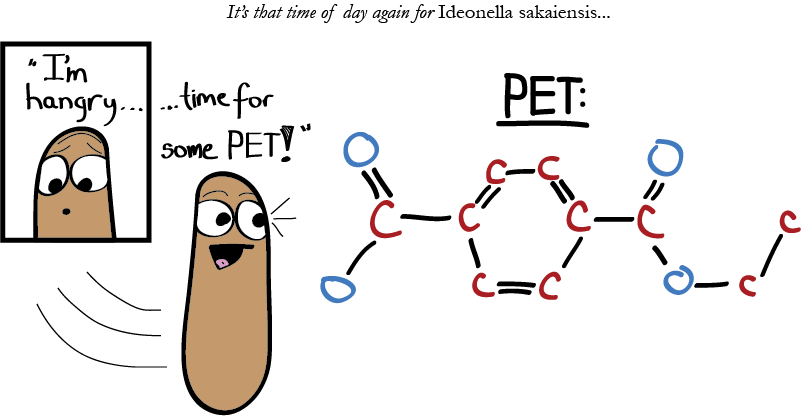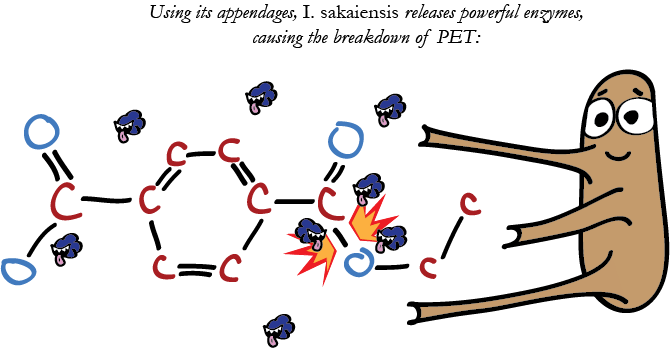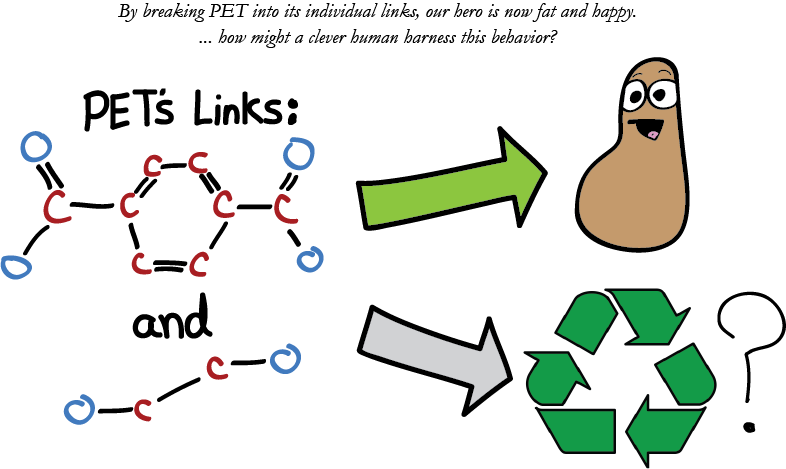Humans do not find plastic bottles tasty. Try as we might, ingestion and digestion of an Auquafina bottle makes for a bad dinner.
On the other hand, some bacteria see plastic bottles as a delicacy. Recently described in a report published in Science, these bugs degrade polyethylene terephthalate, or PET, as part of their balanced diet. PET is versatile, being heavily used used in plastic drink bottles, food packaging, and polyester clothing. As such, PET is a major waste product in landfills and recycling centers, making its efficient disposal and recycling important issue. Bacteria that eat plastic are rare, but may prove useful to humans as we battle the unending buildup of plastic waste.
 Many bacteria release enzymes that break down their surroundings, enabling ingestion of nutrients normally too large to handle. The newly discovered bacterium, Ideonella sakaiensis, applies this behavior to a manmade material. I sakaiensis secretes enzymes capable of breaking down PET into its most basic chemicals. PET is a polymer, which is a long, repeating chain of chemicals. The enzymes secreted by I. sakaiensis break PET chains down into their individual links, producing simple chemicals suitable for bacterial consumption or human use.
Many bacteria release enzymes that break down their surroundings, enabling ingestion of nutrients normally too large to handle. The newly discovered bacterium, Ideonella sakaiensis, applies this behavior to a manmade material. I sakaiensis secretes enzymes capable of breaking down PET into its most basic chemicals. PET is a polymer, which is a long, repeating chain of chemicals. The enzymes secreted by I. sakaiensis break PET chains down into their individual links, producing simple chemicals suitable for bacterial consumption or human use.
 Bacterial breakdown of PET is beneficial in many ways. First, PET provides fuel for I. sakaiensis, allowing that bacterium to flourish in PET-rich environments like recycling plants (such as the one where I. sakaiensis was discovered).
Bacterial breakdown of PET is beneficial in many ways. First, PET provides fuel for I. sakaiensis, allowing that bacterium to flourish in PET-rich environments like recycling plants (such as the one where I. sakaiensis was discovered).
Additionally, bacterial remediation of PET may be useful to humans. Given that plastic bottle waste continues to accumulate, finding effective ways to dispel that waste is important. PET recycling is not 100% efficient, so it is possible that I. sakaiensis could be used to transform the plastic into its environmentally friendly constituents.
Even more intriguing is the possibility that the broken down chemicals could be captured and used to make fresh PET. This is perhaps the greatest trick of I. sakaiensis: it breaks down PET in such a way that the links of the chain are still useful, and could theoretically be remade into virgin PET. This contrasts with other polymer-eating microorganisms, which effectively destroy the links of the chain during the break down process. Inserting recycled chemicals into the PET manufacturing pipeline could reduce the amount of petroleum needed for the creation of virgin PET.
The discovery of I. sakaiensis and its PET-degrading capabilities is remarkable. Not only has a bacterium evolved to consume plastic, but it has done so in such a way that humans might be able to use that behavior for our own ends. Just in time, too; I’m not keen on eating water bottles for dinner.
Peer Edited by Rachel Dee
